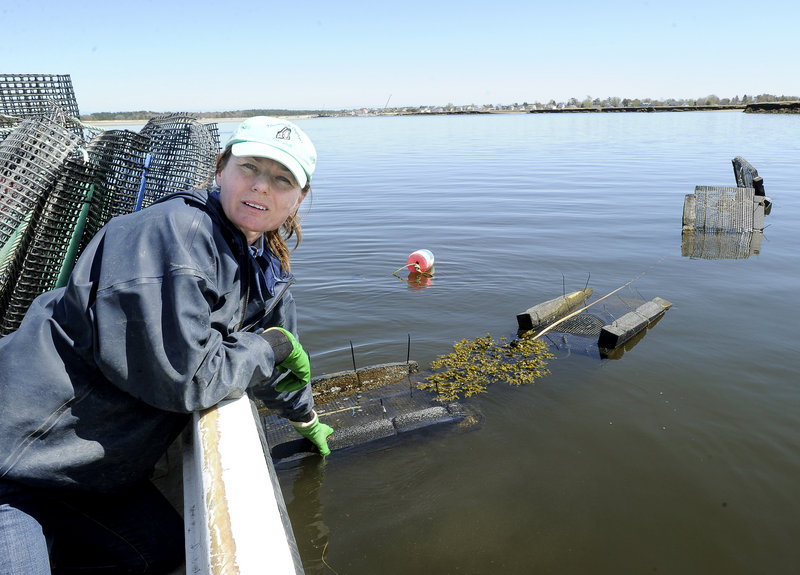The long-awaited public pier at Scarborough’s Pine Point Beach has been a godsend for commercial fisherman who had been ferrying their gear from the shore to their boats until two summers ago.
This year, the pier could also provide a much-needed solution for a local oyster farmer.
The Town Council will vote Wednesday on an agreement that would allow Abigail Carroll to run a nursery for Nonesuch Oysters off the pier.
“The nursery has been the Achilles’ heel in this whole business,” said Carroll, who decided to invest in a startup oyster farm four years ago and soon found herself running it.
She started by buying oysters as juveniles to test her untrained hand at raising them at a farm in the Scarborough River.
(Previously, Carroll worked in telecommunications and business in New York and Paris before returning to her home state.)
Last year, she had an above-ground nursery in Biddeford Pool.
But it was costly to pump water into the nursery, called an upweller, and to transport the oysters to the farm in Scarborough, when they got big enough.
Having a floating nursery at the pier will improve the flow of water — and, in turn, oyster growth — and consolidate the whole operation within a three-minute boat ride, Carroll said.
But she can’t take credit for the idea. It came up in a conversation between her and Harbor Master Dave Corbeau.
Corbeau said the town had an upweller for softshell clams for about 10 years, until a heavy rainstorm in 1996.
“It crashed and sank and we just never did another one,” he said.
Part of the proposed agreement would require Carroll to dedicate one of the eight bins in the nursery to clams, if the town’s Shellfish Committee so chooses.
“It’s a positive thing for the whole river to grow your own product, rather than go buy it,” Corbeau said.
Plus, oysters eat up bacteria from the river and help keep it clean, he said.
Oyster-farming in Maine originated in the 1970s in the Damariscotta River, but now the state’s 45 or so oyster farmers can be found anywhere between Harrington and the New Hampshire border, said Sebastian Belle, executive director of the Maine Aquaculture Association.
The state’s aquaculture industry, which includes salmon, seaweed and muscle farms, is worth nearly $100 million, Belle said.
Town Manager Tom Hall said aquaculture wasn’t on Scarborough’s radar screen when planning for the pier, but considering its negligible impact, he sees no reason not to encourage the use.
“And, on the flipside, I see it as a great way to support a local business,” he said of the agreement, which requires Carroll to pay $420 a year to cover electricity costs.
Carroll has yet to buy her nursery, but said if the council approves the agreement, she’ll do it the next day.
The 8-by-20-foot nursery would float by the pilings near the end of the pier.
The farming process starts with buying baby oysters, or seed, from a hatchery. Carroll said she’d start with 1.5 million of them, which would take up the same amount of space as a loaf of bread.
They’d go into the bins in the spring, and get sorted weekly by size. Some oysters grow faster than others, she said, and the big ones have to be in separate bins from the smaller ones, or they’ll hog the nutrients from the water.
Once they’re about a half-inch big, which should happen between July and September, they’re moved to the farm, where they float in mesh bags attached to lines across the Scarborough River.
They get moved into bags with bigger mesh holes as they grow, to keep the maximum amount of water flowing through. The whole process of growing oysters from seed to 3 inches — the size they are when sold to restaurants like Eventide and Fore Street in Portland — takes about three years.
“The first half-inch of an oyster’s life is critical because they’re so delicate,” Carroll said. “They’re like a baby. They need special care.”
And because of the amount of time they take to grow, one bad season “has repercussions forever,” she said.
Although there are never guarantees when working in nature, Carroll says a nursery by the pier, in the same body of water as the farm, could eliminate some of the variables.
“It provides a consistent environment,” she said.
Staff Writer Leslie Bridgers can be contacted at: 791-6364 or at
lbridgers@pressherald.com
Send questions/comments to the editors.




Success. Please wait for the page to reload. If the page does not reload within 5 seconds, please refresh the page.
Enter your email and password to access comments.
Hi, to comment on stories you must . This profile is in addition to your subscription and website login.
Already have a commenting profile? .
Invalid username/password.
Please check your email to confirm and complete your registration.
Only subscribers are eligible to post comments. Please subscribe or login first for digital access. Here’s why.
Use the form below to reset your password. When you've submitted your account email, we will send an email with a reset code.